Hanging toilet: how to create a refined and unusual interior
No toilet room can do without a toilet, which performs not only a utilitarian function, but also serves as a central decorative part of the interior. Therefore, the choice of this sanitary device should be given increased attention. The main disputes often flare up around the issue, floor or wall mounted toilet to be purchased for the arrangement of the restroom. If everything is clear with the first model, then the latter is not very common in our country, so let's talk about it in more detail.
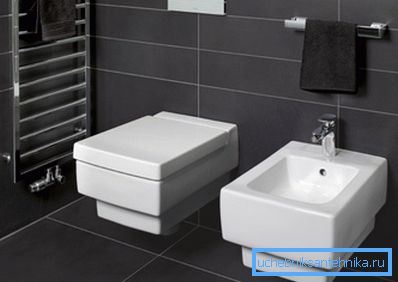
Design features
To make it easier for you to make a decision and not be disappointed in the future about the choice made, consider the design of the sanitary devices mentioned in the title. The described know-how of plumbing - suspended toilet bowls - represent a bowl of a classical form, which is not installed on the floor, but is fixed to the wall, for which a special metal frame is used.

The fastener itself - the so-called installation - can be mounted both near the main wall of the toilet, and in any other place. In apartments, the first option is often preferred, since the area of latrines does not allow for more radical solutions. Moreover, in this case it is easier to organize water supply and sewage systems, without which no sanitary device will work.
The placement of the toilet bowl itself is dictated by the choice of the place for the installation of the flushing cistern. As a rule, together with suspended structures, buried containers are used, which are fixed on the frame, sheathed with plasterboard and faced with ceramic tiles or other decorative material.
To drain the water, a special button is used, which is installed on the wall above the toilet bowl. No other additional equipment, as well as hoses and faucets, bring discord to the sophisticated design of your toilet.
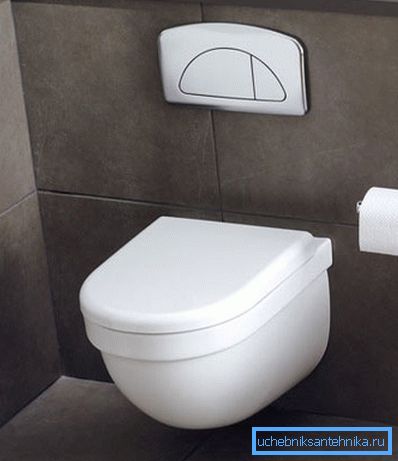
Note! A container hidden in a wall is a common, but not the only option. There is, for example, a toilet with a hanging tank on the pipe. In this case, free access is provided for repair and maintenance of the device, but the interior of the room suffers.
Modern industry produces just a huge range of suspended plumbing devices that can satisfy the needs of even the most demanding customer (if, of course, you are not limited by the price).
Among them:
- white and black hanging toilet, as well as many other models of all imaginable and unimaginable colors and shades;
- wall-hung toilet-bidet with heating, which makes visiting the toilet room as comfortable as possible;
- children's hanging toilet, allowing you to organize your own toilet for the younger generation in the house.
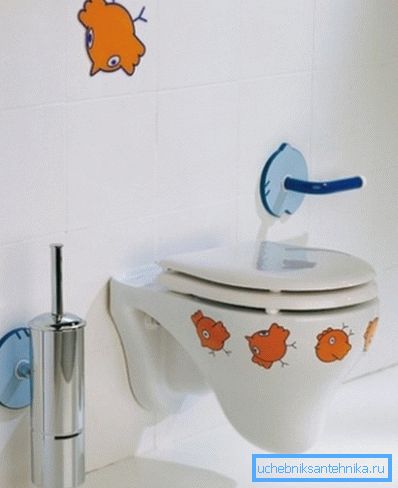
Before you make this difficult choice (after all, rearranging or replacing the plumbing fixture after the completion of the repair will be very problematic), it is recommended to weigh all the pros and cons of the toilet cage outlined in the next section.
Advantages and disadvantages of mounted devices
Positive points
For the first time described plumbing devices appeared in the United States of America at the end of the last century. They already gained considerable popularity, but are now widely used to decorate private houses, apartments, and commercial premises.
Many of the leading publications on interior design, even make up the rating of toilet bowls, which helps to choose one model or another and use it to decorate your own toilet room.
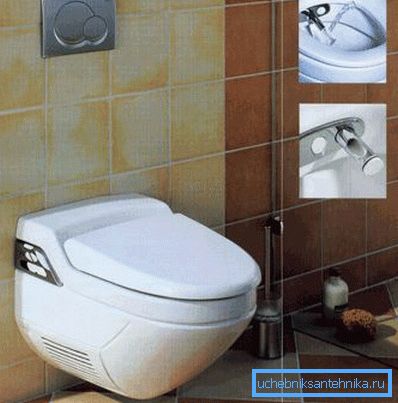
The positive points are as follows:
- Suspended toilets save space. Given that the drainage tank is located inside the wall (in a special niche), the design takes up a minimum amount of space in the toilet, and this makes it possible to more effectively use the vacated space.
- Do not have bulky legs-supports. Due to this, the floor of the toilet room is easier to veneer with ceramic tiles (you can even lay out the panel - the toilet will not interfere). In addition, cleaning is simplified many times over: there is no need to mop around a pedestal, which has a complex shape and does not allow to clean the tile qualitatively.
- The use of special design models allows you to create an unusual and fresh interior space. You do not need to figure out how to disguise the tank. He is already safely hidden under the wall covering.

Negative points
Considering all the pros and cons of a suspended toilet, it is impossible not to mention the main argument, which leads the opponents of this design - low reliability. Especially often it is claimed by people whose weight significantly exceeds the norm. Many of them believe that if the suspended toilet is used constantly, sooner or later the fixings will not sustain and the porcelain design will collapse together with the person sitting on it.
This statement is fundamentally wrong for at least two reasons:
- a steel frame mounted on the wall is a reliable guarantee that the brackets will not jump out of the holes and the toilet bowl will hang in the same place where you placed it;
- The instruction manual of the porcelain bowl itself provides for an impact of at least 400 and sometimes 800 kg mass (such loads can not always withstand classical designs).

The second controversial point is the complexity of service. Indeed, how can you replace broken drain fittings or repair a leaky hose liner if the tank is lined with tiles?
One answer should be to this: it is claimed by people who are not familiar with the design of modern toilet bowls. The fact is that the installation is designed to provide convenient and unhindered access to all elements that can fail or require periodic maintenance.

As for the installation itself, it is as simple as possible. Complete with the toilet comes everything you need for its installation.
Tip! Using different parts from the same collection, you can even make changes to the bathroom interior from time to time. For example, change the drain button on the tank or install a new, more attractive from your point of view, tap on a bidet.
Features of operation
Before making a rating for the best hanging toilet bowls and going to a specialty store for a purchase, it is recommended that you familiarize yourself with some of the nuances of using the described sanitary devices:
- Choosing the size of the device, take into account the dimensions of the frame for installation and the drain tank. If the latter will not be mounted in a niche, you need to leave more space or choose a less massive structure. In this case, the frame will protrude beyond the limits of the main wall and occupy a part of the toilet room space. Add thickness of gypsum plasterboard and tile with glue here.
- If along the wall, to which the toilet will be installed, water and sewage pipes are laid, it is imperative to check that these engineering structures will not prevent the frame from fastening. If so, consider moving them to another location.
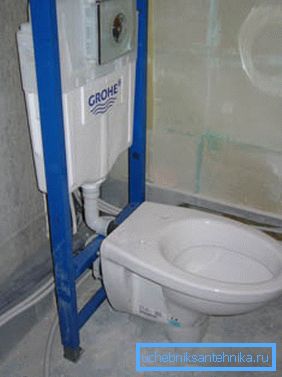
- When flush mounting the cistern (in a niche), it is advisable to make water connections using a rigid tube, rather than a rubber hose reinforced with steel threads. The first option is more reliable and durable.
Installation Procedure
Although the installation of a suspended toilet is not difficult, it is better to entrust the implementation of this process to a hired team of builders who have the relevant experience and skills, and also have the necessary tools to carry out the work.
If you want to save as much as possible, then get ready to do the following work with your own hands:
- Install the frame. Dowels or anchor bolts of suitable diameter are used for this. Fastening should be made only to the main wall, as thin interior partitions made of foam blocks or bricks, and especially drywall, probably will not withstand the load. During installation, carefully observe the vertical and horizontal. This will help water or laser level.
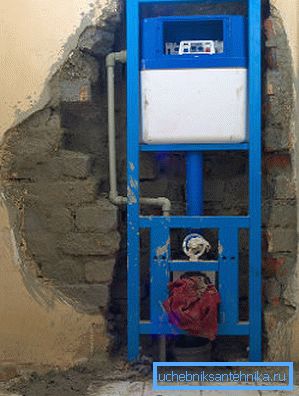
At the same time you need to take care of sewage and water supply. If the neck of the drain pipe fits perfectly with the frame, no further action is necessary. Otherwise, you can connect the nozzles with a corrugated toilet cuff, after having previously missed the joints with a sanitary seal.
- Having installed the sewage system and running the water supply to the tank, you need to install the bowl in place and carry out the tests: drain the water and make sure that the liquid normally enters the tank and does not seep at the joints of the corrugations with the pipes.
- At the same stage, the height of the brackets above the floor level is adjusted with the help of special bolts. Pick up this value can be empirically, focusing on the growth of tenants.
- After fixing the frame, it is sheathed with sheets of drywall. Take the material with a green substrate, it is designed for installation in rooms with high humidity levels.
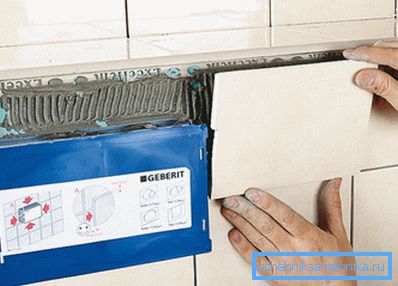
- The next stage of performance of work - facing decorative material. Most often on the wall tile is mounted. Use special adhesives for the most durable connection.
- The last stage - fixing the toilet bowl.
Conclusion
After reading the article, you were able to make sure that a toilet with a cistern is not only beautiful, but also a reliable solution that allows you to effectively organize the space in the toilet, give the room a refined and unusual appearance, as well as disguise the unattractive looking water supply and sewage pipelines. . For more on this, see the video in this article.